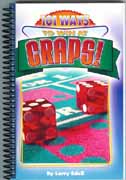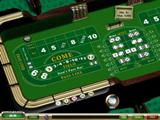
101 Ways to Win at Craps
Ten major chapters (plus a glossary, resources page and index) cover the entire range of craps play. Each chapter is divided into ten sections. For example, the Pass and Come Methods includes information on how to make odds-only bets; betting before the come out; making money with place bets; pushing the house; making money with come bets; protecting your pass line bet; betting don't; multiple odds table; remembering odds; making money on a cold table.
The book also includes $50 worth of free coupons.
How to Win a Converted Come Bet in Craps
Most of us were taught to play the pass line with odds, and have two come bets up. Come bets are liked by most players because they represent the hot numbers. By betting the come, many people Larry Edell has been the editor of 'The Crapshooter Newsletter' since 1994. He has published nine books and over two hundred different articles in magazines such as 'Casino Player', 'Gaming Today', 'Mid West Players 'and 'Gambling Times'. Larry's website is www.thecrapshooter.com believe that they can take advantage of a hot streak or a "monster roll." In addition, come bettors often take double (or more) odds, both on the pass and come lines, to maximize their wins.
Larry Edell has been the editor of 'The Crapshooter Newsletter' since 1994. He has published nine books and over two hundred different articles in magazines such as 'Casino Player', 'Gaming Today', 'Mid West Players 'and 'Gambling Times'. Larry's website is www.thecrapshooter.com believe that they can take advantage of a hot streak or a "monster roll." In addition, come bettors often take double (or more) odds, both on the pass and come lines, to maximize their wins.
The come bet, however, does have some disadvantages. Let's say you have a come bet on the six and eight, nine was the point, and the point was made. You now have a six and eight working on the come-out, with odds. If the seven hits now, you would win your new pass line bet, but lose the flat portion of your "left over" come bets.
Another disadvantage is that the payoffs for come bets are not much higher, and in many cases lower, than equal place bets. For example, a $10 come bet on the six with $25 odds returns $30 for the odds plus $10 on the flat portion, a total of $40. However, if you bet $36 on the six as a place bet, you would win back $42. In addition, you can not take down a come bet. If you stay on the come line with every roll, eventually you'll lose all of the flat portions of your bets.
Craps pros know that a number has to hit twice for a come bet to win, compared to once for a place bet. Instead of having your come bet poised to follow the trend of the table, it is easier and more profitable just to make what is called a converted come bet.
A converted come bet is a place bet that is made instead of the corresponding come bet. For example, if the first roll is, say, a four and the next two rolls are five and six, you might normally have come bets of $10 with odds on the five and six - $20 odds on the five and $25 on the six. So, you have a total of $65 in play - $30 on the five and $35 on the six. Betting the come bets and winning, you would have won $40 on the five and $40 on the six, a total of $80.
Instead of betting on the come, you could just place $30 on the five and $36 on the six, giving you $66 in play. You would win $42 on the five and $42 on the six, for a total of $84. Of course, you can then take your bets down so you don't have to worry about the come out seven (if the point was made), or the two, three, or twelve (while in the come box).
The next time you want to make a come bet, try a converted come bet instead.

